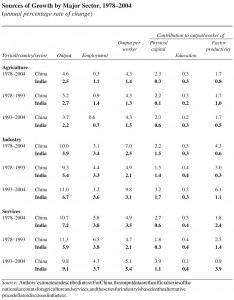In their article Accounting for Growth: Comparing China and India, Bosworth and Collins investigate the rapid growth these two countries have experienced in the past 35 years. To do this, the authors use an equation where the output is growth and the inputs are TFP, physical capital services, and capital’s share of income. (For those interested the equation is: ∆ln(Y/L = α [∆ln(K/L)] + (1-α)∆lnH + ∆lnA, where Y is output, A is TFP, K is physical capital services, and α is capital’s share of income.) Through the use of this equation, they are able to look at the causes of growth in the two countries. It is important to note that TFP does not include just technological advances, but also other determinants of the efficiency of factor usage such as government policy or weather.

Aggregate Growth Accounts
 Decomposing the causes of growth allows the authors to see what each country has done well and what improvements could be undertaken. India faces the problems of low investment, a weak infrastructure, and a lack of highly educated people. India’s literacy rate stands at 76% while China’s is a near perfect 99%. Since the authors have concluded that an increase of one year in average schooling leads to a 7% increase in TFP, they came to the conclusion that China’s growth has been mainly due to an increase in TFP. A corollary from this is that if India were not only to increase education but also to increase investment, its growth would accelerate and its infrastructure would strengthen.
Decomposing the causes of growth allows the authors to see what each country has done well and what improvements could be undertaken. India faces the problems of low investment, a weak infrastructure, and a lack of highly educated people. India’s literacy rate stands at 76% while China’s is a near perfect 99%. Since the authors have concluded that an increase of one year in average schooling leads to a 7% increase in TFP, they came to the conclusion that China’s growth has been mainly due to an increase in TFP. A corollary from this is that if India were not only to increase education but also to increase investment, its growth would accelerate and its infrastructure would strengthen.
Sectoral Growth Accounts
 The authors then use sectoral growth accounting to reveal the individual impacts of agriculture, industry, and services on growth. Both countries have benefited from the green revolution and have had agriculture remain a key factor in growth. China’s agricultural growth is especially exceptional because increases in both output per worker and rates of TFP growth that more than double India’s were able to overcome falling employment. India’s employment in agriculture has increased, but the authors surmise that this is due to a lack of jobs in the industry and service sectors. China’s industry growth accounts for 50% of its GDP, compared to India’s 30%. India’s strongest growth sector is services; however, China’s service growth still surpasses that of India. While China’s growth is broad across all sectors, India’s growth remains focused on the service sector.
The authors then use sectoral growth accounting to reveal the individual impacts of agriculture, industry, and services on growth. Both countries have benefited from the green revolution and have had agriculture remain a key factor in growth. China’s agricultural growth is especially exceptional because increases in both output per worker and rates of TFP growth that more than double India’s were able to overcome falling employment. India’s employment in agriculture has increased, but the authors surmise that this is due to a lack of jobs in the industry and service sectors. China’s industry growth accounts for 50% of its GDP, compared to India’s 30%. India’s strongest growth sector is services; however, China’s service growth still surpasses that of India. While China’s growth is broad across all sectors, India’s growth remains focused on the service sector.
Future Prospects
Future growth prospects for each country remain optimistic. The authors find no evidence that China’s growth will come to a halt. India’s potential for growth is much more limited, however. While China’s investment level has increased, much of this growth is used to finance public sector debt. Private investment has increased, but at a level half that of China’s. The authors note that, while prospects for both countries remain strong, growth will depend on continued integration with the global economy.
Potential Data Inaccuracies?
It is important to recognize that India’s growth is still remarkable; it pales only in comparison to China’s. Even though both countries have become wealthier, neither of them come close to attaining the wealth level that the United States has reached. Many questions regarding the data remain unanswered, however. Since India’s growth is largely in the service sector, the researchers had to rely on household surveys to collect their data. Could this method of data acquisition have caused inaccuracies? Also, many economists believe that China’s growth has been overstated; the authors themselves admit that China’s growth numbers have substantial margins of error. While there are some questions regarding the specifics of the growth of these two countries, there seems to be no debate that there is significant growth, and that fact leaves many curious as to just how long these growth rates can be sustained.
In regards to China’s high level of public sector debt, is there any way to know how much of that debt is a result of China’s developmental state policies and domestic investment?
What about India’s rapidly growing youth demographic? India’s population, if left unchecked, is supposed to pass China’s within the next few decades. Will this bountiful working population turn the tide against China’s aging workforce?